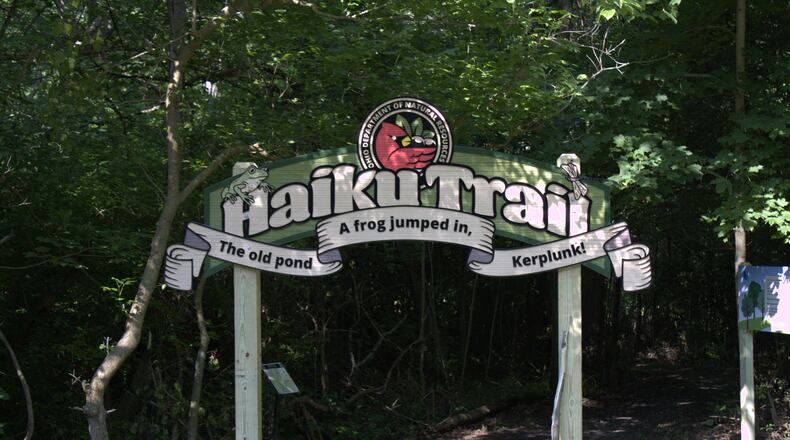“It’s a different audience than our storybook trails which are obviously for young children,” Yaple said. “I think the great thing about the haiku trail though is the poems are short enough that they could speak to children, but they also speak to adults.”
ODNR partnered with Haiku North America to bring the project to life. In April, the organization put out a call to its members for submissions and received more than 400 before narrowing it down to the final 20 to be posted.
Credit: Contributed by Patti Niehoff
Credit: Contributed by Patti Niehoff
Patti Niehoff, a member of Haiku North America, donated the trail and served as a local arrangements chair with her husband Buck Niehoff for the organization’s annual conference in Cincinnati this year. The conference, coordinated by program chair Jennifer Hambrick and the Niehoffs, included the trail dedication on July 2. Patti Niehoff hopes the trail will expose more people to poetry and haiku as an artform especially.
“It’s a way of getting people outside of yourself,” Patti Niehoff said. “There’s opportunities for you to write your own, for you to experience it on a personal level. I like getting people involved in the writing of it, to see it’s not a complicated thing.”
At the end of the trail, a sign with a QR code encourages hikers to take inspiration from the trail and submit their own haiku. Buck Neihoff said the park plans to publish the submissions on their website.
Haiku are simple 3-line poems. While Americans often think they have to follow a 5-7-5 syllable structure, Patti Niehoff said that isn’t the case. The format comes from Japanese culture, which doesn’t consider syllables in the same way the English language does. Instead, Patti Niehoff said the more important aspect is simplicity and connection to nature.
“It’s very involved with nature,” she said. “It’s involved with paying attention to your world. Since it’s such a short form, there’s not really any room to get silly.”
For people who walk the new haiku trail, the intention is to slow down. The path features three benches to sit and observe nature while thinking about the haiku. One overlooks the creek, another looks out onto a wetland area, and the third sits at the top of a steep hill looking down on a creek.
The trail at Hueston Woods is the first of its kind at a state park, but it isn’t totally unique. The Inn at Honey Run, located outside Millersburg, features Julie Warther’s Haiku Walk. Unlike Hueston Woods’ trail where the poems are posted on leaf-shaped metal plaques attached to trees, the haiku at the Inn are engraved on metal plaques and attached to rocks.
Across the U.S., Yaple said haiku trails are rare. When she started working on this project last fall, she looked to other countries like New Zealand and Japan for inspiration. She planned for the new haiku trail to be a one-off feature, but there’s already interest elsewhere in the state.
“We’ve already heard from another group in northwest Ohio that is interested in a haiku trail in their area,”Yaple said, “so it may grow into something more than we intended.”
Visitors at Hueston Woods can find the haiku trail at at the old location for the Sycamore Trail in the north end of the park. Parking is available at the Sycamore Grove Picnic Area.
About the Author

